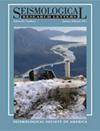佩科斯阵列:特拉华盆地德克萨斯州佩科斯地区的临时节点地震实验
IF 3.2
3区 地球科学
Q2 GEOCHEMISTRY & GEOPHYSICS
引用次数: 0
摘要
自2009年以来,随着特拉华州盆地地震的增加,迫切需要在特拉华州盆地进行地震研究,包括精确的震源,以识别产生地震的构造,并确定它们是否与非常规石油开发和生产有关。2018年,在德克萨斯州地震网络的资助下,我们在特拉华州盆地的德克萨斯州Pecos地区部署并维护了一个由25个Magseis Fairfield Z-Land Generation 2个5-Hz地震节点组成的节点网络,称为Pecos阵列。该网络于2018年11月至2020年1月初部署,并在2020年9月和10月记录了另外两个月的数据。该网络以1000hz的采样率连续采集三分量数据。节点的间距从市中心的~ 2公里到离市中心的~ 10公里不等。这个网络的主要目标是提高对震源的估计,这将有助于确定过去几年地震增加的原因。在本文中,我们总结了该网络的科学动机、部署细节和数据质量。数据质量统计表明,我们成功地收集了具有信噪比的连续数据,使我们能够检测和定位事件,其中数百个事件的估计为ml<0.50。这个独特的数据集有助于在特拉华盆地进行新的地震构造研究。本文章由计算机程序翻译,如有差异,请以英文原文为准。
The Pecos Array: A Temporary Nodal Seismic Experiment in the Pecos, Texas, Region of the Delaware Basin
Abstract With increasing earthquakes in the Delaware basin since 2009, earthquake studies, including accurate hypocenters, are critically needed in the Delaware basin to identify the structures producing earthquakes, and to determine if they are related to unconventional petroleum development and production. In 2018, with funding from the Texas Seismological Network, we deployed and maintained a nodal network of 25 Magseis Fairfield Z-Land Generation 2 5-Hz seismic nodes in the Pecos, Texas, region of the Delaware basin, known as, The Pecos Array. The network was deployed from November 2018 to the beginning of January 2020, with an additional two months of data recorded in September and October 2020. The network collected continuous three-component data with a 1000-Hz sampling rate. The spacing of the nodes varied from ∼2 km in town to ∼10 km farther away from the city center. The primary goal of this network was to improve estimation of event hypocenters, which will help to determine why there has been an increase in earthquakes over the past several years. In this article, we summarize the scientific motivation, deployment details, and data quality of this network. Data quality statistics show that we successfully collected continuous data with signal-to-noise ratios that allow us to detect and locate events, hundreds of them being estimated at ML<0.50. This unique dataset is contributing to new seismotectonic studies in the Delaware basin.
求助全文
通过发布文献求助,成功后即可免费获取论文全文。
去求助
来源期刊

Seismological Research Letters
地学-地球化学与地球物理
CiteScore
6.60
自引率
12.10%
发文量
239
审稿时长
3 months
期刊介绍:
Information not localized
 求助内容:
求助内容: 应助结果提醒方式:
应助结果提醒方式:


